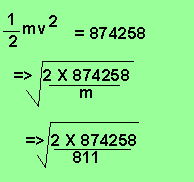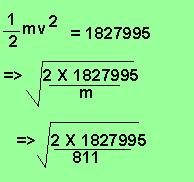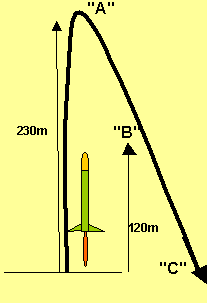Solution
The kinetic energy at "B" is 874258 joules. The expression below
is true.

v = 46.43m/s
Click to hide the solution
Solution
The rocket has only gravitational potential energy at "A". The
mass of the rocket does not include the mass of fuel which is exhausted
by the time the rocket reaches peak altitude.
mgh = 811 X 9.8 X 230 = 1,827,995 joules.
Click to hide solution
Solution
The rocket has gravitational potential energy equal to
mgh = 811 X 9.8
X 120 = 953736 joules
Now the rocket started
to fall from "A" with a gravitational potential energy of
mgh = 811 X 9.8 X 230 =1827994 joules.
The difference between the two potential energies ( the potential at "A"
and the potential at "B") is the kinetic energy the rocket has at
"B".
1827994 - 953736 = 874258 joules.
Click to hide the solution
Solution
The kinetic energy at "B" is 874258 joules. The expression below
is true.

v = 46.43m/s
Click to hide the solution
Solution
The energy the rocket has at "C" is all kinetic. The amount of kinetic energy is equal to the gravitational potential energy at "A".

v = 67.14m/s
Click to hide solution
|
Gravitational
into kinetic exercises 2
|
|
|
1) A rocket has a total mass of 1200kg (includes 389 kg of fuel) sits on the launch pad. After launch it reaches a maximum altitude of 230m where it momentarily comes to a stop. Assume no air resistance or energy loss from the system.
Solution b)
What is the gravitational potential and kinetic energies of the rocket
at "B"? Solution c)
What is the speed of the rocket at "B" Solution d) What is the speed of the rocket at "C" assuming that "C" is at ground level. Solution |
 |